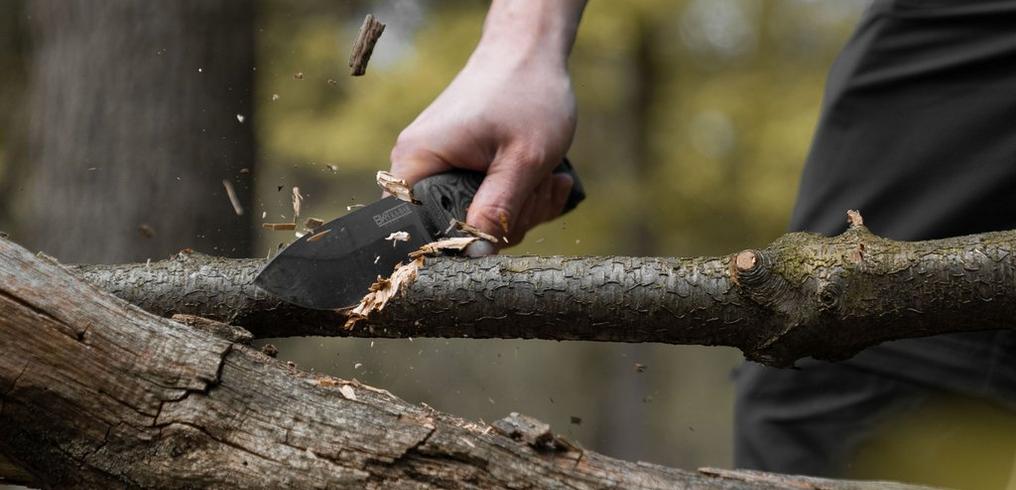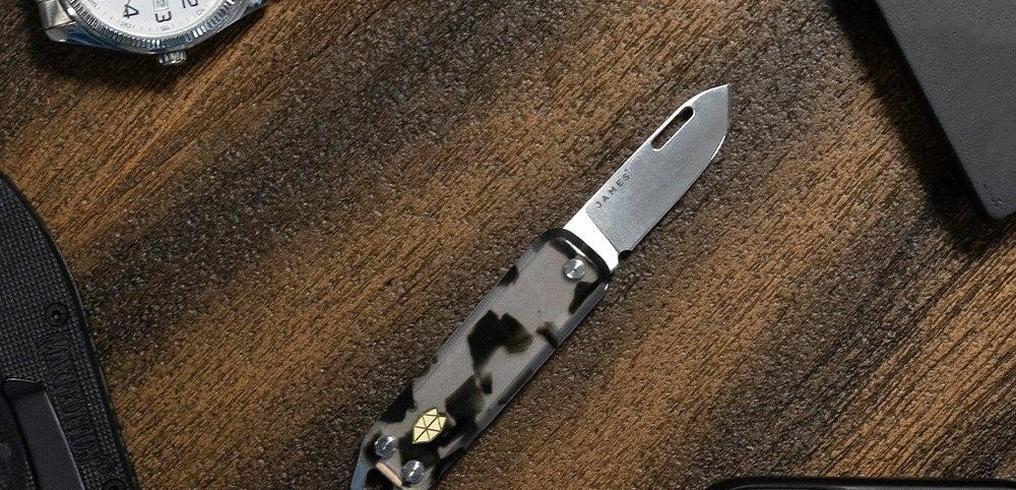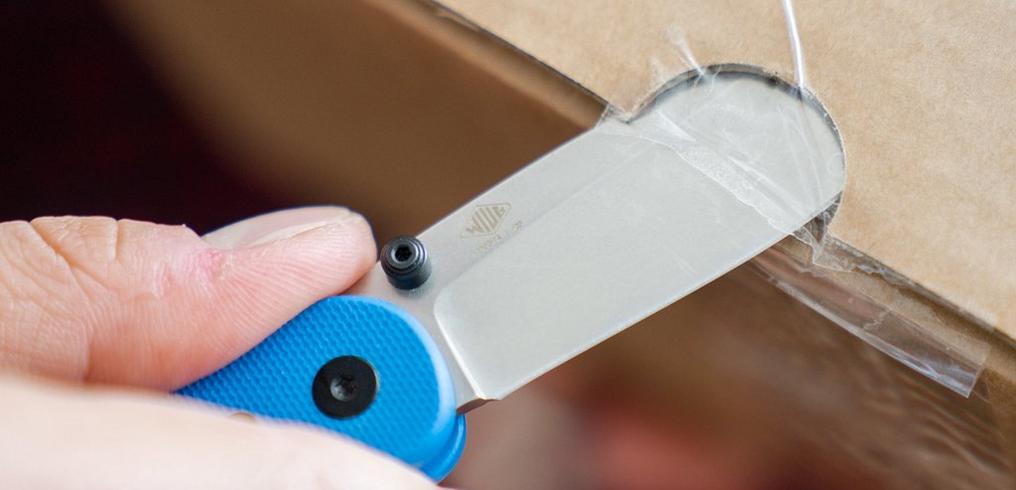KA-BAR Becker BK2 Expert Review | Taking a Different Approach
Taking a Different Approach
I have always been an advocator of having the right tools for the job. If I need to split wood, I use a hatchet. If I want to carve a spoon, I use a spoon carving knife. Because of this, the knife on my hip tends to be no longer than 4 inches, with a relatively thin width, and so far I have had no need for anything bigger.
However, many of my fellow outdoorsmen prefer themselves to carry a one-tool-option, and to know and trust that the knife on their belt is going to be there for anything that they might call upon it for. Be that cutting up the evening meal or ploughing through knotty pine logs.
I have always been curious as to how this would actually play out in practice, so I decided to ditch the tool roll, and try my hand at using just one tool for all my outdoor chores for a while, and there is no knife I could think better suited to this experiment, than the KA BAR Becker BK2.
A “Survival” Knife in a Bushcraft World
Everyone is familiar with this knife. In fact, it is one of the most sold knives on the Knivesandtools website I believe; and it really needs no introduction. There are scores of reviews and forums out there on it.
I have seen this poor knife been put through more misuse and abusive scenarios than any other knife out there. It’s been used to pry open doors, to hammer into a tree and used as a stepladder, to slice up old gas stoves, to baton through rusty iron nails and even cinder blocks. You name it, I’m sure it’s been tried, and the consensus is always the same...this tank of steel is tough as nails.
So, with that being said, I wanted to test this knife based on my own experience, and what I look for in a knife. It’s all well and good seeing this knives amazing ability to destroy things, but coming from a bushcraft background, rather than a hardcore survival background, I have never really needed my knife to pry open the door of a Humvee. I wanted to see if a knife like this could be an option for the types of scenarios I typically find myself in when I’m in the woods. Tasks that sometimes require a higher degree of precision than I had thus far seen the BK2 perform.
Materials
The price point, materials and fit of this knife, for me at least, lend themselves to a kind of “working man’s tool” feeling about the BK2. It feels as though you can chop and change it to your own needs, and it doesn’t feel precious, which is good, because I did end up having to make a few of my own modifications to suit my needs, but we can get to that later.
The steel is a powder-coated 1095 Cro-Van with a factory edge of 20 degrees. Cro-Van, a steel also used by Bark River Knives, is said to have an advantage over regular 1095, improving the edge retention and toughness with the introduction of Chromium and Vanadium.
The simple scales are nothing to write home about, except for the fact that they are extremely comfortable! Constructed from Ultramid® moulded plastic, they simply get the job done, and they do it well. An interesting observation I noticed while introducing myself to Becker knives, was that the scales are exactly the same shape and design on most of their range. This again lends itself to that sort of, working mans, no nonsense feeling to these blades. Function before form. It’s no wonder Ethan Beckers motto is “Becker knives work for a living”, and listening to him speak about his ethos, he has said; ”basically, what I’ve always wanted my knives to be known for...is being extremely useful...and that includes being comfortable to use”.
Chopping, Processing and Crafting
There is no mistake about it, the BK2 is certainly a statement piece. At 6.3mm thick, weighing a total of 453 grams, it is by far the chunkiest knife I have personally used for more than 2 minutes before handing it back to its respective owner in horror. That being said, before long, the balance and ergonomics really started to make themselves apparent with the BK2, and I found I was very much enjoying how it was performing.
A chopping tool
Considering this is supposed to be a one-tool-option, and since I do not have a saw or an axe in this scenario, could I process a log into usable firewood. In situations where the forest floor is soaked from rain (which happened to be to be the case on this day) you have two options when it comes to fire material. Either you find dead standing wood that is off the forest floor, or you split and process logs into their smaller parts in order to access the dry wood inside. Finding a recently downed beech tree I started to chop.
Note: Green wood is not a good option for firewood, and it will burn smokey and give off relatively little heat, because all the energy produced from the fire will be absorbed in drying out the moisture in the wood, rather than burning the fuel. But for the purposes of this demonstration I used this green beech log.
In this task, the BK2 performed brilliantly. The distribution of weight in the blade is such that using it as a chopper allows a significant amount of weight to be guided towards the chop. The shape of the back of the scales allows for the hand position to sit comfortably, and it genuinely feels like a very natural motion. If I am honest, chopping with a knife this extensively is definitely something new to me, but after a while of using this knife, I found myself naturally going to this option as a means to remove wood when doing other tasks. The reality is that a knife is never going to out-perform a tool specifically designed for this job, an axe. But if this was all I had, it is absolutely possible, and comfortable to perform this task for quite a long period, and my hand never got tired or sore. However! If I was to improve the knives ability to perform here, I would possibly raise the angle on the cutting edge from the factory 20 degree to around 25 degrees. And so this was added to my list of modifications.
A processing tool
Having processed a chunk of this log down, I then went about splitting it further in order to making it usable for a fire lay. This included batoning, prying and feathering the wood. The BK2 had zero issues with any of these tasks. I was not going easy on the blade, having made a makeshift baton, I was hitting it in every which way through the knots and prying the log apart. It should be noted that under KA BAR Becker warranty, batoning is considered misuse of the tool, so if you snapped your blade doing this, then you may have trouble getting to warranty on the blade. But I think you would have to be doing something pretty outrageous to snap this piece of steel.
Following this I tried feathering to get some very fine material that would catch a flame. With this, the BK2 was equally exceptional, the 20 degree edge coming into play with these slicing motions meant I had no issue getting fine curls, even after the abuse it had just been through with the batoning.
A crafting tool
Arguably, the BK2 struggled here. Fashioning a simple tent peg calls for a number of techniques. Chopping, push cuts and some finer detailed notching tasks. With the face and belly of this blade simply being so large, 43mm at its widest point, it is simply not made for woodworking. That being said! It will get the job done for you, and the drop point is quite comfortable for push cuts and finer details. For basic camp craft chores the BK2 will not let you down. However, I feel that a simple scandi grind bushcraft style blade is always going to be more appropriate where these types of tasks are concerned.
A Note on the Sheath
One of the things I wanted to try when I got this knife, was how an Armatus Carry sheath fared against the stock one, and whether or not it’s worth the money to upgrade. Firstly, I will say the stock sheath is absolutely fine, and will certainly serve its purpose. However; with higher quality design choices, aesthetics and manufacturing finishing, I feel that the Armatus sheath is the superior option here, and vastly improves the functionality and enjoyment of using the BK2.
This is hardly surprising, considering Armatus Carry are solely dedicated to creating amazing sheaths, and I think KA BAR can be forgiven here for losing this round.
The main differences between the two is the fact that the Armatus BK2 sheath is made of a single piece of folded kydex, rather than a two piece bolt together system like the stock one. This means the knife sits super snugly and will not budge, and pulling/pushing the knife free will not see two pieces come apart slightly, as you get with the stock sheath. The thumb ramp on the Armatus feels more satisfying also, aesthetic considerations are a bonus.
The mil-spec pull the dot soft loops are tough as nails! I found them a little stiff at the beginning, and it took me a little time to get used to the mechanics of the system, but once I did, they were working for me beautifully. There is no way this knife is coming off your belt unless you want it to.
I did however, have two small problems with the sheath, despite all of its positives. Firstly, the soft loops are too short to securely wrap around the sheath to allow the knife to be carried in a Scout orientation, as you would see with most of their sheaths, so really the only carry option here is with a dangler. Considering the BK2 sheath is one of the largest they do, this is understandable, but I’m hoping in the future there will be an option for longer soft loops. The second issue is simply that the vinyl logo came off the sheath after I had been out in the rain. This is purely an aesthetic thing, and has no effect on the performability of the sheath, but it is worth noting here.
All that being said, it is an absolutely amazing sheath and I will be using them in future for the rest of my knives. If you are picking up a BK2, I would definitely recommend adding this sheath to your list. But back to the knife!
Fit for Purpose?
After using the BK2 for a while, I made note of a few things I wanted to modify for it to be a truly useful tool for my outdoor needs.
A usable knife spine for spark production
There are varying opinions out there concerning powder coated blades. Some people enjoy the assurance that their blade is not going to rust, so long as the coating is there. Personally, I have found them to be more trouble than they’re worth. Understandably, in certain situations this is unavoidable, but basic maintenance of a carbon blade is usually enough to prevent it from being destroyed by the elements. Cold or hot bluing is a more versatile option, and any spots of surface oxidation here or there can be quickly sanded away. Over time a carbon blade will naturally form its own patina, which helps its corrosive resistance.
Powder coating also completely nulls a blades ability to catch a spark, either with a ferrocerium rod or from a chip of flint or iron. When I got this knife I removed a portion of the coating to see if it would catch a spark, but the spine is slightly rounded so it was still useless for this. I decided then to completely strip the coating from the blade, and file the spine down so it sat at a sharp 90 degree angle. Following this I applied a cold bluing to the blade to maintain a protective layer against corrosion, allowing it to be used in conjunction with a ferro rod.
Secondary bevel reprofile
It should be noted here that the choice to modify the cutting angle of this blade was purely a preferential decision. The BK2 is an extremely good cutting tool straight out of the box, but with a factory edge of 20 degrees, it could be argued that this is better suited to blades used for slicing and game processing. A 25 degree angle lends itself to a more robust and effective choice for my own needs, which would be mostly wood processing and material removal.
Revisiting tasks
After these modifications were made I decided to see if it could produce a bow drill set for me, which I processed from a large chunk of willow.
This task involved almost everything the same as the last time; chopping a small piece from a large log, splitting it down, and then crafting some smaller items. At this stage I was becoming fairly comfortable with knowing what the BK2 could accomplish, and it was no surprise to me that it had no issues getting the job done. From a log to an ember, using only one tool. This was a first for me, and it solidified my confidence in this tool, knowing I could rely on it.
Conclusion
There is no such thing as the perfect knife. Everyone’s needs and uses for their blade varies, and it takes time and experience to find something that meets your needs. I went into this experiment being comfortable with knowing that a setup I would typically use in the woods had tools for chopping, sawing, carving and processing, and sure, the BK2 should never be expected to out-perform the tool for the job in any of these tasks.
That being said, having the knife, and only the knife with me, I was forced to think differently. In some ways, it actually gave me more confidence than if I were to be carrying a range of tools, employing a certain kind of adaptive mindset brought my relationship with this tool a little closer than if it were only one of a range of tools to hand.
Using it exclusively, I found, more and more, that I could guess and feel how it would handle certain tasks or angles. Even if I do return to my tool roll, after the BK2, I will certainly be expecting more of my belt knife, whatever that knife may be. It is quite simply an excellent choice, and if I was dropped out of a plane with one tool strapped to my hip, I could do worse than to have a KA-BAR BK2 by my side.
Padraig Croke
Padraig Croke is the host of the outdoors podcast Trial by Fire, which ran from 2018-2023. A graphic designer and photographer by day, as well as an avid outdoorsman and bushcraft enthusiast, when he's not writing for us he's usually out in the field making film or taking photographs.

You can find his work at www.padraig.me or by following him on instagram @padraigcroke
Thanks, Padraig, for this awesome review!
?%24center=center&%24poi=poi&%24product-image%24=&fmt=auto&poi=%7B%24this.metadata.pointOfInterest.x%7D%2C%7B%24this.metadata.pointOfInterest.y%7D%2C%7B%24this.metadata.pointOfInterest.w%7D%2C%7B%24this.metadata.pointOfInterest.h%7D&scaleFit=%7B%28%24this.metadata.pointOfInterest%29%3F%24poi%3A%24center%7D&sm=c&w=762)
?%24center=center&%24poi=poi&%24product-image%24=&fmt=auto&poi=%7B%24this.metadata.pointOfInterest.x%7D%2C%7B%24this.metadata.pointOfInterest.y%7D%2C%7B%24this.metadata.pointOfInterest.w%7D%2C%7B%24this.metadata.pointOfInterest.h%7D&scaleFit=%7B%28%24this.metadata.pointOfInterest%29%3F%24poi%3A%24center%7D&sm=c&w=762)
?%24center=center&%24poi=poi&%24product-image%24=&fmt=auto&poi=%7B%24this.metadata.pointOfInterest.x%7D%2C%7B%24this.metadata.pointOfInterest.y%7D%2C%7B%24this.metadata.pointOfInterest.w%7D%2C%7B%24this.metadata.pointOfInterest.h%7D&scaleFit=%7B%28%24this.metadata.pointOfInterest%29%3F%24poi%3A%24center%7D&sm=c&w=762)
?%24center=center&%24poi=poi&%24product-image%24=&fmt=auto&poi=%7B%24this.metadata.pointOfInterest.x%7D%2C%7B%24this.metadata.pointOfInterest.y%7D%2C%7B%24this.metadata.pointOfInterest.w%7D%2C%7B%24this.metadata.pointOfInterest.h%7D&scaleFit=%7B%28%24this.metadata.pointOfInterest%29%3F%24poi%3A%24center%7D&sm=c&w=762)
?%24center=center&%24poi=poi&%24product-image%24=&fmt=auto&poi=%7B%24this.metadata.pointOfInterest.x%7D%2C%7B%24this.metadata.pointOfInterest.y%7D%2C%7B%24this.metadata.pointOfInterest.w%7D%2C%7B%24this.metadata.pointOfInterest.h%7D&scaleFit=%7B%28%24this.metadata.pointOfInterest%29%3F%24poi%3A%24center%7D&sm=c&w=762)
?%24center=center&%24poi=poi&%24product-image%24=&fmt=auto&poi=%7B%24this.metadata.pointOfInterest.x%7D%2C%7B%24this.metadata.pointOfInterest.y%7D%2C%7B%24this.metadata.pointOfInterest.w%7D%2C%7B%24this.metadata.pointOfInterest.h%7D&scaleFit=%7B%28%24this.metadata.pointOfInterest%29%3F%24poi%3A%24center%7D&sm=c&w=762)
?%24center=center&%24poi=poi&%24product-image%24=&fmt=auto&poi=%7B%24this.metadata.pointOfInterest.x%7D%2C%7B%24this.metadata.pointOfInterest.y%7D%2C%7B%24this.metadata.pointOfInterest.w%7D%2C%7B%24this.metadata.pointOfInterest.h%7D&scaleFit=%7B%28%24this.metadata.pointOfInterest%29%3F%24poi%3A%24center%7D&sm=c&w=762)
?%24center=center&%24poi=poi&%24product-image%24=&fmt=auto&poi=%7B%24this.metadata.pointOfInterest.x%7D%2C%7B%24this.metadata.pointOfInterest.y%7D%2C%7B%24this.metadata.pointOfInterest.w%7D%2C%7B%24this.metadata.pointOfInterest.h%7D&scaleFit=%7B%28%24this.metadata.pointOfInterest%29%3F%24poi%3A%24center%7D&sm=c&w=762)
?%24center=center&%24poi=poi&%24product-image%24=&fmt=auto&poi=%7B%24this.metadata.pointOfInterest.x%7D%2C%7B%24this.metadata.pointOfInterest.y%7D%2C%7B%24this.metadata.pointOfInterest.w%7D%2C%7B%24this.metadata.pointOfInterest.h%7D&scaleFit=%7B%28%24this.metadata.pointOfInterest%29%3F%24poi%3A%24center%7D&sm=c&w=373)
?%24center=center&%24poi=poi&%24product-image%24=&fmt=auto&poi=%7B%24this.metadata.pointOfInterest.x%7D%2C%7B%24this.metadata.pointOfInterest.y%7D%2C%7B%24this.metadata.pointOfInterest.w%7D%2C%7B%24this.metadata.pointOfInterest.h%7D&scaleFit=%7B%28%24this.metadata.pointOfInterest%29%3F%24poi%3A%24center%7D&sm=c&w=373)
?%24center=center&%24poi=poi&%24product-image%24=&fmt=auto&poi=%7B%24this.metadata.pointOfInterest.x%7D%2C%7B%24this.metadata.pointOfInterest.y%7D%2C%7B%24this.metadata.pointOfInterest.w%7D%2C%7B%24this.metadata.pointOfInterest.h%7D&scaleFit=%7B%28%24this.metadata.pointOfInterest%29%3F%24poi%3A%24center%7D&sm=c&w=762)
?%24center=center&%24poi=poi&%24product-image%24=&fmt=auto&poi=%7B%24this.metadata.pointOfInterest.x%7D%2C%7B%24this.metadata.pointOfInterest.y%7D%2C%7B%24this.metadata.pointOfInterest.w%7D%2C%7B%24this.metadata.pointOfInterest.h%7D&scaleFit=%7B%28%24this.metadata.pointOfInterest%29%3F%24poi%3A%24center%7D&sm=c&w=373)
?%24center=center&%24poi=poi&%24product-image%24=&fmt=auto&poi=%7B%24this.metadata.pointOfInterest.x%7D%2C%7B%24this.metadata.pointOfInterest.y%7D%2C%7B%24this.metadata.pointOfInterest.w%7D%2C%7B%24this.metadata.pointOfInterest.h%7D&scaleFit=%7B%28%24this.metadata.pointOfInterest%29%3F%24poi%3A%24center%7D&sm=c&w=373)
?%24center=center&%24poi=poi&%24product-image%24=&fmt=auto&poi=%7B%24this.metadata.pointOfInterest.x%7D%2C%7B%24this.metadata.pointOfInterest.y%7D%2C%7B%24this.metadata.pointOfInterest.w%7D%2C%7B%24this.metadata.pointOfInterest.h%7D&scaleFit=%7B%28%24this.metadata.pointOfInterest%29%3F%24poi%3A%24center%7D&sm=c&w=762)




?%24center=center&%24poi=poi&%24product-image%24=&fmt=auto&h=490&poi=%7B%24this.metadata.pointOfInterest.x%7D%2C%7B%24this.metadata.pointOfInterest.y%7D%2C%7B%24this.metadata.pointOfInterest.w%7D%2C%7B%24this.metadata.pointOfInterest.h%7D&scaleFit=%7B%28%24this.metadata.pointOfInterest%29%3F%24poi%3A%24center%7D&sm=c&w=1016)

?%24center=center&%24poi=poi&%24product-image%24=&fmt=auto&h=490&poi=%7B%24this.metadata.pointOfInterest.x%7D%2C%7B%24this.metadata.pointOfInterest.y%7D%2C%7B%24this.metadata.pointOfInterest.w%7D%2C%7B%24this.metadata.pointOfInterest.h%7D&scaleFit=%7B%28%24this.metadata.pointOfInterest%29%3F%24poi%3A%24center%7D&sm=c&w=1016)


